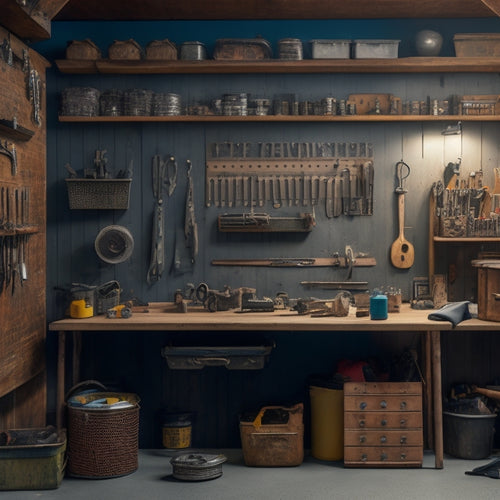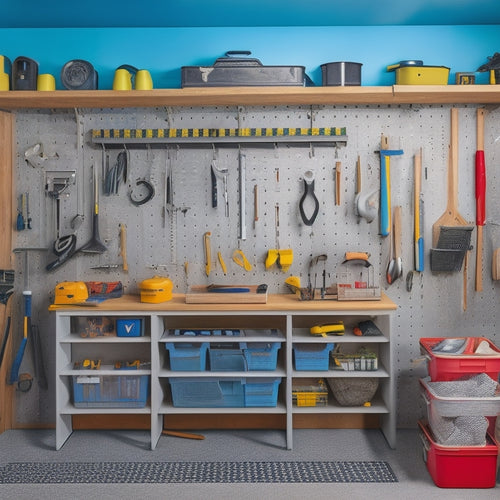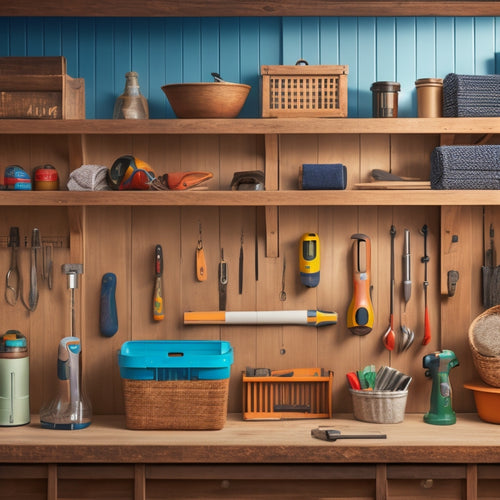
Key Considerations for Hanging Hooks Installation
Share
When hanging hooks, you'll need to take into account the type of hook, weight capacity, and wall material to guarantee a secure hold. Measure and mark the wall accurately, choosing the right hook size and anchor for the job. In high-traffic areas, prioritize durability and stability, and don't forget about aesthetics - your hooks should complement the space. You'll also need to manage cables and wires, identify potential hazards, and maintain your hooks regularly. With so many factors at play, it's crucial to get it right - and by understanding these key considerations, you'll be well on your way to a successful installation that's both functional and safe.
Key Takeaways
- Choose the right type of hook based on the item's weight, size, and material to ensure safe and secure hanging.
- Consider the wall material and use appropriate anchors to provide a strong and reliable hold.
- Measure and mark the wall accurately to ensure proper alignment and avoid weak spots.
- Select durable materials and follow manufacturer's instructions for installation to prevent accidents and ensure longevity.
- Regularly inspect and maintain hooks to identify potential issues and extend their lifespan.
Types of Hanging Hooks Available
When it comes to hanging hooks, you have a wide range of options to choose from, depending on your specific needs and the type of items you want to hang.
Decorative hooks, for instance, can add a touch of elegance to your walls while serving their functional purpose. They come in various styles, from modern and minimalist to traditional and ornate, allowing you to match them with your interior design.
On the other hand, specialty hooks cater to specific needs, such as hanging bicycles, tools, or even plants. These hooks are designed with the unique requirements of the item in mind, guaranteeing a secure and stable hold.
For example, hooks designed for hanging heavy objects like bikes often have reinforced materials and extra support to prevent damage or accidents.
Ultimately, the type of hook you choose will depend on the item you want to hang and the surface you're attaching it to.
Weight Capacity and Load Limits
Several factors contribute to a hook's overall performance, but none are more critical than its weight capacity and load limits. You must consider these factors to guarantee the safety of the items you're hanging and the people around them.
A hook's weight capacity is the maximum weight it can hold without failing or breaking. This capacity is determined by the hook's material strength, design, and load distribution.
When selecting a hook, you need to think about the weight of the item you're hanging, as well as any additional weight that might be applied, such as when someone accidentally pulls on the item.
You should also consider the load distribution, as uneven weight distribution can put additional stress on the hook, reducing its capacity.
Make certain to choose a hook with a weight capacity that exceeds the weight of the item you're hanging, and always follow the manufacturer's instructions for installation and use. By doing so, you can guarantee a safe and secure hanging solution.
Wall Material and Anchors Needed
The type of wall material you're working with greatly influences the type of anchor you'll need to securely install your hanging hook. Different wall types require different anchor materials to guarantee a safe and secure installation.
For instance, if you're working with drywall, you'll need to use plastic or metal anchors that can grip the soft material. On the other hand, if you're installing a hook on a concrete or brick wall, you'll need to use heavy-duty anchors made of steel or zinc that can penetrate the hard surface.
When it comes to hollow walls, such as those made of plywood or MDF, you'll need to use specialized anchors that can spread the weight of the load across the entire wall. In contrast, solid walls like those made of wood or metal can use simpler anchors that screw directly into the surface.
Measuring and Marking the Wall
Now that you've selected the right anchor for your wall type, it's time to measure and mark the wall where you'll install the hanging hook. To verify proper alignment, take out your level and hold it against the wall to confirm it's straight.
Measure the distance from the floor or any other reference point to where you want the hook to be, using a tape measure or ruler. Make a small mark with a pencil at the desired spot.
Next, check the wall's stability by gently pressing on it or knocking on it to identify any hollow spots or weaknesses. This is essential to avoid installing the hook on a weak area that mightn't hold the weight.
Double-check your measurements and marks to verify they're accurate and level. Use a fine-tip marker to draw a small line or an "X" at the mark, making it easier to spot when drilling.
Remember to hold the marker straight and level to maintain proper alignment. With your marks in place, you're ready to move on to the next step – drilling and installing your anchor and hanging hook.
Choosing the Right Hook Size
Every hanging hook installation requires a hook that's proportional to the weight and size of the item you're planning to hang. You need to evaluate the hook's material, design, and size to guarantee it can hold the weight without compromising safety.
| Hook Type | Weight Capacity | Suitable For |
|---|---|---|
| Small Plastic | Up to 5 lbs | Hanging small decorative items |
| Medium Metal | 5-20 lbs | Hanging bikes, tools, or bags |
| Large Stainless Steel | 20-50 lbs | Hanging heavy equipment or machinery |
When choosing a hook, assess the material type. Plastic hooks are suitable for light loads, while metal hooks are more durable and can handle heavier weights. Stainless steel hooks are ideal for humid or wet environments. Hook design variations, such as screw-in or adhesive hooks, also impact the weight capacity and ease of installation. Always check the manufacturer's specifications to confirm the hook you choose can support the weight of the item you're hanging. Remember, safety should always be your top priority when installing hanging hooks.
Accounting for Cable and Wire Management
When installing hanging hooks, you'll need to contemplate how to manage cables and wires to maintain a clutter-free and organized space.
You'll want to decide on cable hiding strategies, such as using cable ties or cord concealers, to keep unsightly cords out of sight.
Cable Hiding Strategies
You'll want to employ cable hiding strategies to maintain a clutter-free and visually appealing installation. Exposed cables and wires can be unsightly and even hazardous, so it's crucial to incorporate effective cable management into your hanging hooks installation.
To achieve aesthetic integration, consider running cables behind walls, baseboards, or crown molding. This will help conceal unsightly wires and create a sleek, streamlined look. You can use cable clips, cable ties, or cable organizers to keep cables tidy and organized. These tools will help you manage cables of varying lengths and thicknesses, ensuring a professional-looking finish.
When selecting cable hiding strategies, prioritize safety above all else. Avoid pinching or bending cables, as this can cause damage or even electrical shock.
Instead, choose methods that allow for smooth, gentle cable routing. By doing so, you'll create an installation that's not only visually appealing but also safe and reliable.
Wire Organization Methods
To maintain a clutter-free installation, organizing wires and cables is just as important as hiding them from view. You'll want to implement effective wire organization methods to guarantee a safe and efficient setup. Start by grouping similar cables together, using cable ties or zip ties to keep them bundled. This makes it easier to identify and access specific wires when needed.
Consider investing in wire storage solutions, such as cable organizers or cord concealers, to keep excess cable length tidy.
When it comes to cable management techniques, route cables along walls or baseboards to minimize visibility and reduce tripping hazards. Use cable clips or adhesive-backed cable straps to secure wires to surfaces, keeping them out of the way.
Label each cable or wire to avoid confusion and make future maintenance a breeze. By implementing these wire organization methods, you'll reduce clutter, improve safety, and create a more professional-looking installation.
Considerations for High-Traffic Areas
When you're installing hanging hooks in high-traffic areas, you can expect heavy use, so it's essential to choose hooks that can withstand the wear and tear.
Anchor points become especially important in these areas, as they provide added stability and support.
You'll also need to guarantee secure fastening to prevent hooks from coming loose over time.
Heavy Use Expected
Frequently, high-traffic areas in homes, offices, or public spaces require hanging hooks that can withstand the constant flow of people and heavy usage. When installing hooks in these areas, you'll want to take into account the usage frequency and choose hooks that are designed to handle the extra wear and tear.
In high-traffic areas, it's crucial to select hooks with a sturdy build and a high weight capacity. You should also take into account the hook placement, making sure that it's easily accessible yet secure enough to prevent accidental unhooking.
For instance, if you're installing hooks in a busy hallway or entryway, you may want to opt for hooks with a tamper-proof design or those that require a bit more force to unhook. Additionally, you should space the hooks far enough apart to prevent overcrowding, reducing the likelihood of hooks getting tangled or damaged.
Anchor Points Matter
Because high-traffic areas put an immense amount of stress on hanging hooks, you must pay close attention to the anchor points that support them.
It's vital to guarantee that the anchor points can handle the increased load distribution in these areas. You should choose anchor points that are specifically designed for high-traffic areas and can withstand the weight and stress of frequent use.
When selecting anchor points, consider the type of installation techniques used. For example, will you be using screws, nails, or adhesives to secure the hooks?
Make certain the anchor points are compatible with the chosen installation method. Additionally, consider the material of the wall or surface where the hooks will be installed. This will help you determine the type of anchor point that will provide the most secure hold.
Secure Fastening Needed
You've selected anchor points that can handle the weight and stress of high-traffic areas, now it's time to focus on secure fastening. In these areas, it's vital to guarantee that your hanging hooks are fastened securely to prevent accidents and damage.
When it comes to fastening methods, you'll want to choose techniques that provide a strong and reliable hold. For example, screwing into studs or using wall anchors can provide extra support.
Additionally, consider using fastening methods like toggle bolts or molly bolts, which can distribute weight more evenly. It's also important to follow the manufacturer's instructions for installation techniques, as improper installation can lead to weakened fastening.
Aesthetics and Design Elements
When choosing hanging hooks, consider the overall aesthetic you want to achieve in your space. You'll want to select hooks that complement the style and design elements of your room.
Hook styles vary widely, from modern and sleek to ornate and traditional. Choose a style that fits your space's unique character.
Visual balance is also essential when installing hanging hooks. You'll want to distribute the hooks in a way that creates harmony and balance in the room.
Consider the weight and size of the items you'll be hanging, as well as the layout of the surrounding furniture and decor. Aim to create a sense of symmetry, but don't be afraid to add some visual interest with strategically placed hooks.
Safety Precautions and Hazards
Hanging hooks can pose hidden dangers if not installed correctly, so it's important to identify potential hazards before drilling into your walls. You'll want to avoid electrical shock, for instance, by keeping hooks away from outlets, switches, and other electrical components.
Also, be mindful of plumbing lines and pipes, as you don't want to puncture them and cause water damage or leaks.
When it comes to hook safety, consider the weight capacity of your hooks and the items you plan to hang. You should also verify the hooks are securely fastened to the wall to prevent them from falling or detaching.
Installation hazards like loose screws, stripped anchors, or poorly secured hooks can lead to accidents and injuries. To mitigate these risks, use high-quality hooks and anchors, and follow the manufacturer's instructions carefully.
Additionally, consider consulting with a professional if you're unsure about any aspect of the installation process. By taking these precautions, you can guarantee a safe and successful hanging hooks installation.
Maintenance and Repair Requirements
Behind every successfully installed hanging hook lies a commitment to regular maintenance and prompt repairs. You can't just install a hook and forget about it; you need to guarantee it remains safe and functional over time. This means incorporating preventive maintenance into your routine, such as regularly cleaning the hook and checking for signs of wear or damage.
You should also conduct routine inspections to identify any potential issues before they become major problems. Check the hook's load capacity, look for rust or corrosion, and test its stability. If you notice any issues, address them promptly to avoid accidents. Don't wait until the hook fails, as this can lead to injuries or damage to property.
Additionally, keep a record of your maintenance and repairs to track the hook's history and guarantee you're staying on top of its upkeep. By staying proactive, you can extend the life of your hanging hook and maintain a safe environment.
Frequently Asked Questions
Can I Install Hanging Hooks on a Freshly Painted Wall?
You can install hanging hooks on a freshly painted wall, but wait until the paint is fully dry, usually 24-48 hours, and choose hooks with a gentle grip or adhesive to avoid damaging the new paint.
How Do I Clean Hooks Without Damaging the Surrounding Wall?
When cleaning hooks, you'll want to avoid harsh chemicals or abrasive materials that can damage surrounding wall surfaces. Instead, gently wipe hooks with a soft cloth and mild soap, taking care not to scratch or scrape hook materials.
Are Hanging Hooks Suitable for Use in Humid or Wet Areas?
Did you know 80% of households experience water damage? When hanging hooks in humid or wet areas, you'll want to choose moisture-resistant materials, like stainless steel or brass, to prevent rust and guarantee a secure hold.
Can I Reuse Old Screws or Anchors From Previous Installations?
You shouldn't reuse old screws or anchors from previous installations, as their durability may be compromised, and compatibility with new hooks can be uncertain, which can lead to safety risks and potentially disastrous consequences.
Do Hanging Hooks Come With a Warranty or Guarantee?
Imagine the weight of your worries lifting - do hanging hooks come with a warranty or guarantee? You'll be relieved to know that many reputable brands offer warranty coverage, ensuring hook durability and giving you peace of mind.
Conclusion
You've finally reached the end of the hook-hanging expedition! Now, your walls are adorned with hooks that hold strong, like a steady anchor in a stormy sea. By considering the types, weight capacity, wall material, and aesthetics, you've guaranteed a secure and stylish installation. Remember, a well-planned hook installation is like a solid foundation - it's the key to a sturdy and long-lasting structure. With these considerations in mind, you can hang with confidence.
Related Posts
-

Design Considerations for a Custom Pegboard
When designing a custom pegboard, you'll want to start by evaluating your storage needs, considering factors like too...
-

Advantages of a Pegboard System in Your Garage
You can instantly alter your garage into a more organized, efficient, and productive space by installing a pegboard s...
-

What Tools Do I Need for a DIY Wall Organizer
You'll need a variety of tools to complete a DIY wall organizer project. Essential measuring tools include a tape mea...


